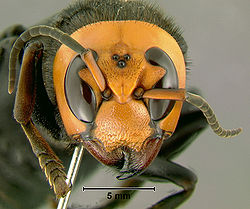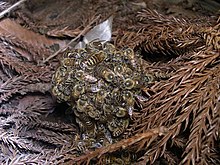Asian giant hornet: Difference between revisions
Darth Panda (talk | contribs) m Reverted edits by 208.68.154.209 to last revision by Alansohn (HG) |
|||
| Line 30: | Line 30: | ||
--> |
--> |
||
== Sting == |
|||
== Sting ==is what kyle engelking deos with himself evry night and is a hermafadite |
|||
The [[stinger|sting]] of the Asian giant hornet is about 6 mm (¼ in) in length,<ref name="ngeo">{{cite web|url=http://news.nationalgeographic.com/news/2002/10/1025_021025_GiantHornets.html|title="Hornets From Hell" Offer Real-Life Fright}}</ref> and injects an especially potent [[venom]] that contains, like many bee and wasp venoms, a [[cytolysis|cytolytic]] [[peptide]] (specifically, a [[mastoparan]]) that can damage tissue by stimulating [[Phospholipase A|phospholipase]] action,<ref>Hirai, Y., Yasuhara, T., Yoshida, H., Nakajima, T. (1981) A new mast cell degranulating peptide, mastoparan-M, in the venom of the hornet ''Vespa mandarinia'' Biomed. Res. 2:447-449</ref> in addition to its own intrinsic phospholipase.<ref>Abe, T., Sugita, M., Fujikura, T., Hiyoshi, J., Akasu, M. (2000) Giant hornet (''Vespa mandarinia'') venomous phospholipases – The purification, characterization and inhibitory properties by biscoclaurine alkaloids. Toxicon 38:1803-1816</ref> Masato Ono, an [[entomology|entomologist]] at [[Tamagawa University]] near [[Tokyo]], described the sensation as feeling "like a hot nail being driven into my leg."<ref name="ngeo">{{cite web|url=http://news.nationalgeographic.com/news/2002/10/1025_021025_GiantHornets.html|title="Hornets From Hell" Offer Real-Life Fright}}</ref>. |
The [[stinger|sting]] of the Asian giant hornet is about 6 mm (¼ in) in length,<ref name="ngeo">{{cite web|url=http://news.nationalgeographic.com/news/2002/10/1025_021025_GiantHornets.html|title="Hornets From Hell" Offer Real-Life Fright}}</ref> and injects an especially potent [[venom]] that contains, like many bee and wasp venoms, a [[cytolysis|cytolytic]] [[peptide]] (specifically, a [[mastoparan]]) that can damage tissue by stimulating [[Phospholipase A|phospholipase]] action,<ref>Hirai, Y., Yasuhara, T., Yoshida, H., Nakajima, T. (1981) A new mast cell degranulating peptide, mastoparan-M, in the venom of the hornet ''Vespa mandarinia'' Biomed. Res. 2:447-449</ref> in addition to its own intrinsic phospholipase.<ref>Abe, T., Sugita, M., Fujikura, T., Hiyoshi, J., Akasu, M. (2000) Giant hornet (''Vespa mandarinia'') venomous phospholipases – The purification, characterization and inhibitory properties by biscoclaurine alkaloids. Toxicon 38:1803-1816</ref> Masato Ono, an [[entomology|entomologist]] at [[Tamagawa University]] near [[Tokyo]], described the sensation as feeling "like a hot nail being driven into my leg."<ref name="ngeo">{{cite web|url=http://news.nationalgeographic.com/news/2002/10/1025_021025_GiantHornets.html|title="Hornets From Hell" Offer Real-Life Fright}}</ref>. |
||
Revision as of 16:29, 10 February 2009
| Asian giant hornet | |
|---|---|

| |
| Scale bar is 5 millimeters | |
| Scientific classification | |
| Kingdom: | |
| Phylum: | |
| Class: | |
| Order: | |
| Family: | |
| Genus: | |
| Species: | V. mandarinia
|
| Binomial name | |
| Vespa mandarinia Smith, 1852
| |
The Asian giant hornet, Vespa mandarinia, also known as the Japanese hornet and known colloquially as the yak-killer hornet, is the world's largest hornet, native to temperate and tropical Eastern Asia. Its body length is approximately 50.8 mm (2.0 in), with a wingspan of about 76 mm (3 in).[1] Queens may reach a length of 55 mm (2.2 in).[2] Due to its size, it is known in Japan as the giant sparrow bee (大雀蜂, oo-suzumebachi).
Anatomy
The head of the hornet is orange and quite wide in comparison to other hornet species. The compound eyes and ocelli are dark brown, and the antennae are dark brown with orange scapes. The clypeus (the shield-like plate on the front of the head) is orange and coarsely punctured; the posterior side of the clypeus has narrow, rounded lobes. The mandible is large and orange with a black tooth (inner biting surface).
The thorax and propodeum (the segment which forms the posterior part of the thorax) of the Asian giant hornet has a distinctive golden tint and a large scutellum (a shield-like scale on the thorax) that has a deeply-impressed medial line; the postscutellum (the plate behind the scutellum) bulges and overhangs the propodeum. The hornet's forelegs are orange with dark brown tarsi (the distal—furthest down—part of the leg); the midlegs and hindlegs are dark brown. Wings are a dark brownish-gray. The tegulae are brown.
The gaster (the portion of the abdomen behind the thorax–abdomen connection) is dark brown with a white, powdery covering; with narrow yellow bands at the posterior margins of the tergite, the sixth segment is entirely yellow. It is similar in appearance to the established European hornet, Vespa crabro.
Geographic distribution

It can be found in Primorsky Krai, Korea, China, Taiwan (where it is called 虎頭蜂; "tiger head bee"), Indochina, Nepal, India, and Sri Lanka, but is most common in mountainous areas of Japan.
Sting
The sting of the Asian giant hornet is about 6 mm (¼ in) in length,[1] and injects an especially potent venom that contains, like many bee and wasp venoms, a cytolytic peptide (specifically, a mastoparan) that can damage tissue by stimulating phospholipase action,[3] in addition to its own intrinsic phospholipase.[4] Masato Ono, an entomologist at Tamagawa University near Tokyo, described the sensation as feeling "like a hot nail being driven into my leg."[1].
An allergic human stung by the giant hornet may die from an allergic reaction to the venom; but the venom contains a neurotoxin called mandaratoxin[5] which can be lethal to people who are not allergic if the dose is sufficient. Between 20 and 40 people die each year in Japan after being stung by giant hornets.[6]
A few interesting notes on Vespa mandarinia's venom and stinger:
- The venom contains at least eight distinct chemicals, some of which damage tissue, some of which cause pain, and at least one which has an odor that attracts more hornets to the victim.
- The venom contains 5% acetylcholine, a greater concentration than is present in bee or other wasp venoms. Acetylcholine stimulates the pain nerve fibers, intensifying the pain of the sting.
- Vespa mandarinia uses its large crushing mandibles, rather than its sting, to kill prey.
- The venom of the Asian giant hornet is more toxic than that of most other bees or wasps, giving this species one of the greatest lethal capacities per colony.
- The enzyme in the venom is so strong that it can dissolve human tissue. On some occasions, the sting may be compared to the effects of a spider bite.
- Like all hornets, V. mandarinia has a barbless stinger, allowing it to sting repeatedly.
Predation
The Asian giant hornet is a relentless hunter that preys on other large insects such as bees, other hornet species, and mantises.

The hornets often attack honey bee hives with the goal of obtaining the honey bee larvae. A single scout, sometimes two or three, will cautiously approach the nest, giving off pheromones which will lead the other hornets to the hive's location.
The hornets can devastate a colony of honey bees: a single hornet can kill as many as 40 honey bees per minute thanks to their large mandibles which can quickly strike and decapitate a bee. It takes only a few of these hornets a few hours to exterminate the population of a 30,000-member hive, leaving a trail of severed insect heads and limbs. The European honey bees Apis mellifera have small stings which do little damage to hornets that are three times their size and twenty times their weight. The honey bees make futile solo attacks without mounting a collective defense, and are easily killed individually by the hornets. Once a hive is emptied of all defending bees, the hornets feed on the honey and carry the larvae back to feed to their own larvae. The hornets can fly up to 60 miles (95 km) in a single day, at speeds up to 25 mph or 40 km/h.[7]
Adult hornets cannot digest solid protein, so the hornets do not eat their prey, but chew them into a paste and feed them to their larvae. The larvae produce a clear liquid, vespa amino acid mixture, which the adults consume; larvae of social Vespidae produce these secretions, the exact amino acid composition varying considerably among species.[8] The passing of nutrition to adult wasps by larvae is widespread in these wasps, and not restricted to the genus Vespa.
Native honey bees

Although a handful of Asian giant hornets can easily defeat the defenses of many individual honey bees, whose small stings cannot inflict much damage against such a large predator, the Japanese honey bee (Apis cerana japonica) possesses a collective defense against them.
When a hornet scout locates and approaches a Japanese honey bee hive it will emit specific pheromonal hunting signals. When the honey bees detect these pheromones, a hundred or so will gather near the entrance of the nest and set up a trap, keeping it open apparently to draw the hornet further into the hive or allow it to enter on its own. As the hornet enters the nest, a large mob of about five hundred honey bees surrounds it, completely covering it and preventing it from moving, and begin quickly vibrating their flight muscles. This has the effect of raising the temperature of the honey bee mass to 47 °C (117 °F). The honey bees can just about tolerate this temperature, but the hornet cannot survive more than 46 °C (115 °F), so it dies. Often several bees perish along with the intruder, but the death of the hornet scout prevents it from summoning reinforcements which would wipe out the colony.[9]
Beekeepers in Japan attempted to introduce the European honeybee in order to increase productivity, however, European honeybees have no defence against the hornet and the colonies are rapidly destroyed by these formidable insects.[10]
Life Cycle
The hornet and the Japanese diet
In Japan's mountain villages, the larvae and pupae of hornets are valued as a delicacy. They are eaten deep fried or as a kind of hornet sashimi.
Hornet supplement manufacturers
Recently, several companies in Asia and Europe have begun to manufacture dietary supplements and energy drinks which contain synthetic versions of secretions of the larvae of Vespa mandarinia, which the adult hornets usually consume. The manufacturers of these products make claims that consuming the larval hornet secretions (marketed as "hornet juice") will enhance human endurance because of the effect it has on adult hornets' performance. Because these products are marketed as dietary supplement rather than pharmaceuticals, they do not have to support their claims. Some studies[11], however, have suggested that the vespa amino acid mixture itself may influence animal performance in minor ways.
One such company, VAAM, manufactures several such hornet-themed supplements. According to the product's nutritional information, these all consist mostly of common amino acids and flavorings.[12]
Notes
- ^ a b c ""Hornets From Hell" Offer Real-Life Fright".
- ^ [1]
- ^ Hirai, Y., Yasuhara, T., Yoshida, H., Nakajima, T. (1981) A new mast cell degranulating peptide, mastoparan-M, in the venom of the hornet Vespa mandarinia Biomed. Res. 2:447-449
- ^ Abe, T., Sugita, M., Fujikura, T., Hiyoshi, J., Akasu, M. (2000) Giant hornet (Vespa mandarinia) venomous phospholipases – The purification, characterization and inhibitory properties by biscoclaurine alkaloids. Toxicon 38:1803-1816
- ^ Abe, T., Kawai, N., Niwa, A. (1982) Purification and properties of a presynaptically acting neurotoxin, mandaratoxin, from hornet (Vespa mandarinia). Biochemistry 21:1693-7
- ^ "Killer hornets get a taste for humans", http://www.timesonline.co.uk/tol/news/world/article582267.ece
- ^ Vespa mandarinia (Asian Giant Hornet) page, vespa-crabro.de
- ^ Hunt, J. H., I. Baker, and H. G. Baker. 1982. Similarity of amino acids in nectar and larval saliva: the nutritional basis for trophallaxis in social wasps. Evolution 36: 1318-1322
- ^ Defensive Adaptations: Heat Tolerance As A Weapon, davidson.edu
- ^ Piper, Ross (2007), Extraordinary Animals: An Encyclopedia of Curious and Unusual Animals, Greenwood Press.
- ^ Effect of amino acid mixture intake on physiological responses and rating of perceived exertion during cycling exercise, PubMed
- ^ "VAAM Ingredients & Nutritional Information". Retrieved 2008-09-13.
